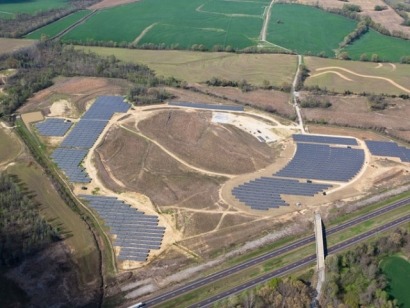
It's fitting then that his home state of Tennessee is becoming one of the Southeast's fastest growing solar power markets.
Last April, a utility-sized solar farm -- the largest in the state -- opened in west Tennessee not all that far a car ride from eiher Graceland, the Historic Sun Studio where Presley made his first records, or Beale Street, where he once walked, shopped for stage clothes and dreamed big teenage dreams.
The West Tennessee Solar Farm consists of more than 21,000 solar PV panels that generate 5 MW of power that is being purchased by the Tennessee Valley Authority (TVA).
Five megawatts is approximately enough energy to power 500 homes each year.
At present, despite a slump in the national solar market, between 6,500 and 7,000 Tennesseans are employed in the solar industry, published reports say. According to the National Renewable Energy Laboratory, the state has a solar PV potential of 20 times the amount of electricity used by its citizens.
But while many politicians and solar proponents see the sun as a boon to economic development and energy independence, some are looking upon the industry's explosive growth and seeing it as a source of revenue to balance the state government's books.
The Tennessee Solar Energy Industries Association (TenneSEIA) has already turned back one effort by the Tennessee General Assembly to increase the taxes paid by solar installations, and the trade group is currently asking candidates for political office to sign a pledge that they will oppose "dramatic and burdensome tax increases on the solar industry."
At present under Tennessee law, solar installations pay next to nothing in taxes as they are seen as fomenting a growth industry in the state. Last year the state's Comptroller of the Treasury proposed taxing solar properties at one-third of their installation value.
TenneSEIA decried that as a potential tax increase of 6,000 percent, and eventually won the day, although the bill could be revived.
Fearing that, the group is currently working on a bill that would exempt solar equipment from sales and use taxes.
In other solar-related news, the TVA is transitioning its exisitng Generation Partners solar incentive program into what it calls its "Green Power Providers program" Oct. 1. The transition, the authority said, was made to help fund newer projects that would not be able to be funded otherwise, based on the response to Generation Partners.
The new funding regime will provide $1,000 in incentive payments to help offset costs for projects with up to 50 KW in size. The program is also increasing contract terms from 10 to 20 years.
The old program, Generation Partners, is considered a cornerstone of the state's solar energy industry, helping to fund the proliferation of nearly 32 MW in solar installations. According to the TVA, about 90 percent of those projects are less than 50 KW in size.
In addition to the TVA, other significant buyers of solar power in the state include Nashville Electric Service and Memphis Light, Gas & Water.
Another southern US state that's doing remarkably well when it comes to solar power is Louisiana, another area steeped in musical history, and -- extending our Elvis connection -- home of the Louisiana Hayride, a popular concert and radio program that helped to propel a very young Elvis to fame.
Louisiana adopted a solar power tax credit in 2008, and since then the industry has experienced meteoric growth. The incentive provides a tax credit worth 50 percent of the cost of an installed system up to a maximum of $12,500.
Some estimates suggest as many as 200 licensed solar installers are now operating around the state.
Like Tennessee, however, success has been a double-edged sword. According to the Louisiana Dept. of Revenue, the state has spent $37 million on the program, roughly 18 times more than was anticipated when the incentive went into effect.
While some lawmakers see that as the cost of job creation and say the expenditures are offset by the new income tax revenue associated with those jobs, others say the cost is just too dear in a state that's struggling to pay for essential services.
It's now anticipated the program will be revised when the legislature meets this fall, but it's currently unclear what those changes will look like.
How are other southern US states doing?
In, Florida, America's "Sunshine State," the Florida Solar Energy Industries Association has been working with state lawmakers to develop a means to support renewable energy without incurring additional cost to Florida tax payers or ratepayers.
The association identified two methods they say will do just that. One method is through low interest renewable energy loans, and the second is through a renewable energy benefit fund (REBF). Both involve reapportioning money currently being collected by some investor owned utility companies.
In Georgia, the first large-scale solar development came online this summer, and just today, Georgia Power launched a new solar energy education initiative, along with a website, to provide comprehensive information and personalized assistance for customers interested in learning more about solar energy.
State and industry officials have also predicted that projects already in the works will increase the state's solar power generation to 50 MW by 2015.
For additional information:
Tennessee Solar Energy Industries Association
Louisiana Solar Energy Society

